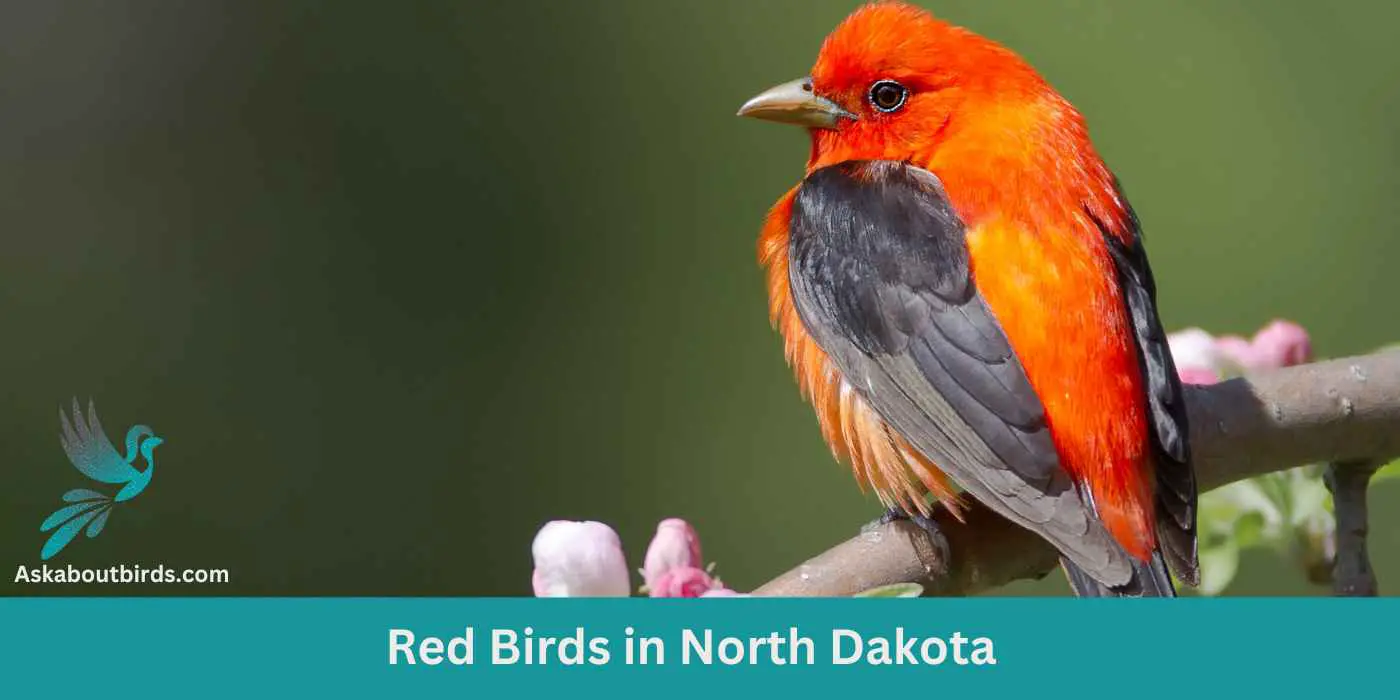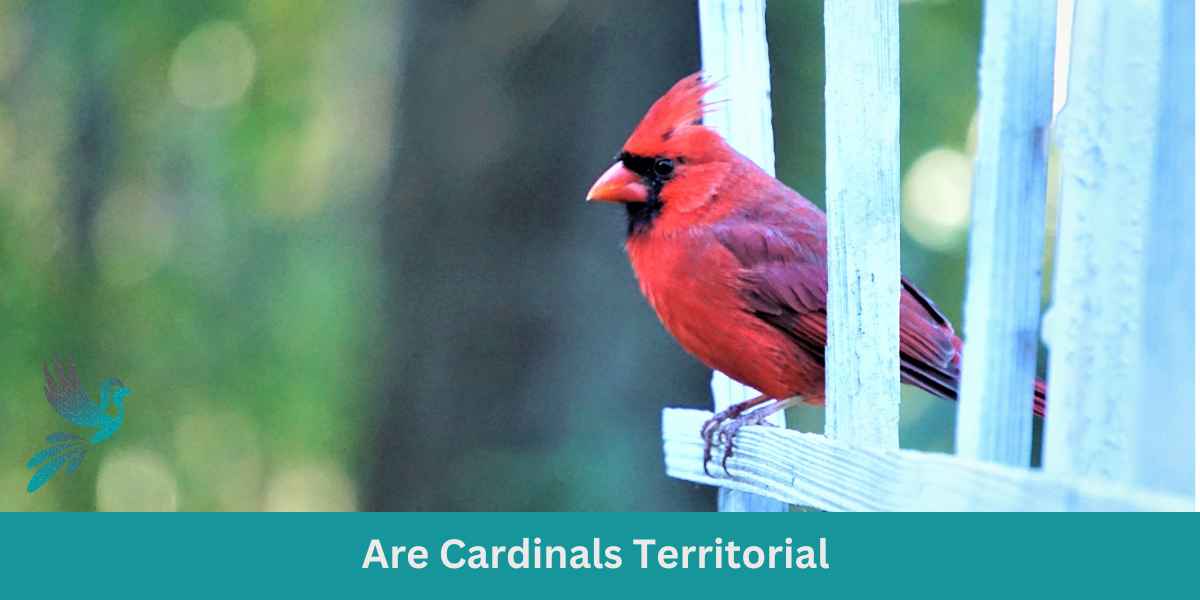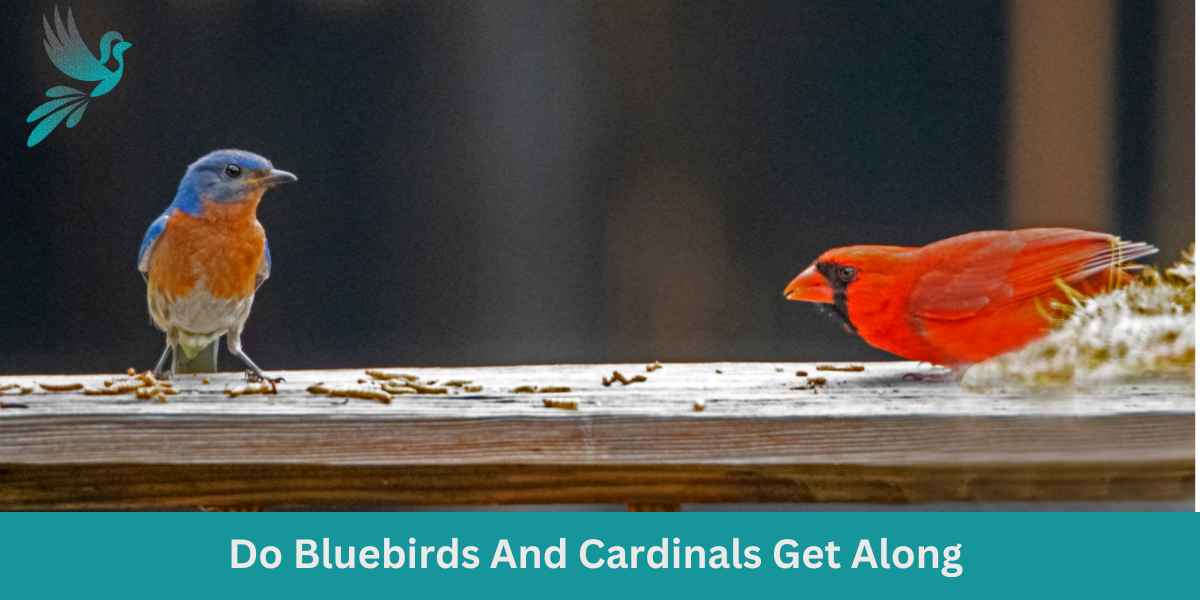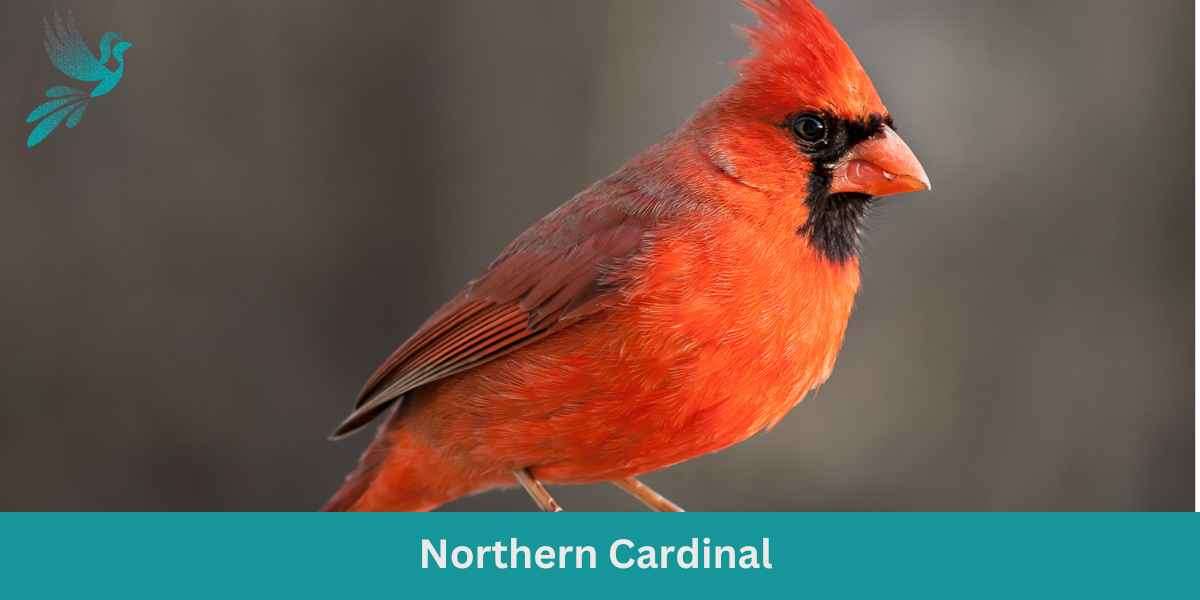Stretching across the vast plains and rolling prairies, North Dakota offers more than just picturesque landscapes. This heartland state is a treasure trove for bird enthusiasts, boasting a myriad of vibrant avian species. Among these winged wonders, the red birds stand out with their striking hues, telling tales of nature’s artistry.
So, ready your senses and let’s embark on this ornithological journey together!
Red Birds Found In North Dakota
Bordered by the languid flow of the Missouri and Red Rivers, North Dakota’s geographical mosaic is a blend of the rugged Badlands, fertile farmlands, dense forests, and sparkling lakes.
This diverse topography, complemented by its position on the Central Flyway, makes the state a migratory superhighway for countless bird species.
Northern Cardinal
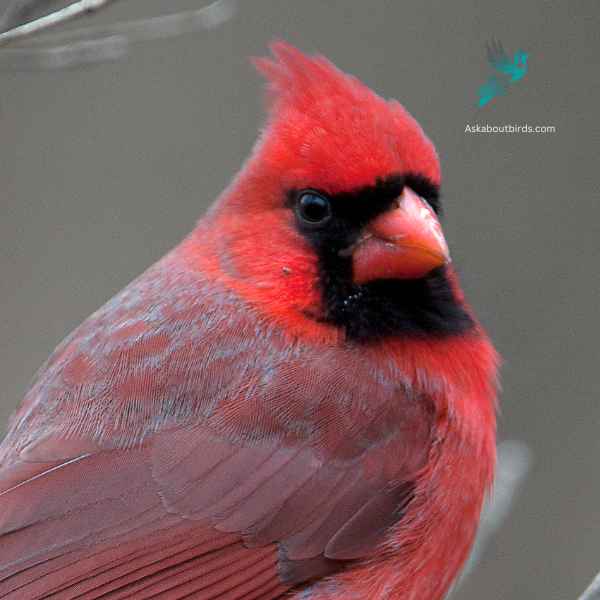
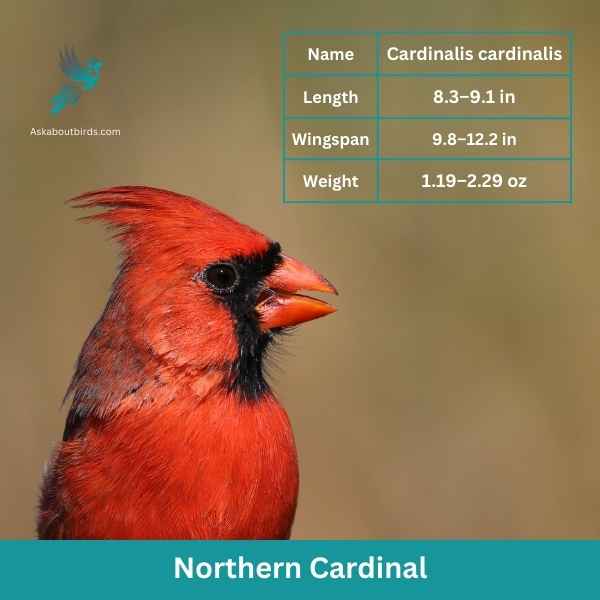
| Feature | Measurement |
|---|---|
| Scientific Name | Cardinalis cardinalis |
| Length | 8.3 – 9.1 in |
| Wingspan | 9.8 – 12.2 in |
| Weight | 1.19 – 2.29 oz |
The Northern Cardinal is an iconic North American bird, easily recognized by its vibrant color and melodious song.
Appearance: Male Northern Cardinals are a brilliant scarlet red, while females display a more subdued reddish olive. Both sexes have a distinctive black ‘mask’ on their face around the bill and a pointed crest on their head. The bird’s beak is robust, cone-shaped, and bright orange in color.
Diet: Northern Cardinals are primarily granivorous, with a diet largely consisting of seeds and grains. They also eat fruits and insects. These birds typically feed off the ground and are frequent visitors to bird feeders.
Reproduction: Northern Cardinals are monogamous, and a pair will breed together for life. The female typically builds a well-hidden nest in a dense thicket or shrub. She lays 2-5 eggs per clutch, which she incubates for around two weeks.
Red-Winged Blackbird
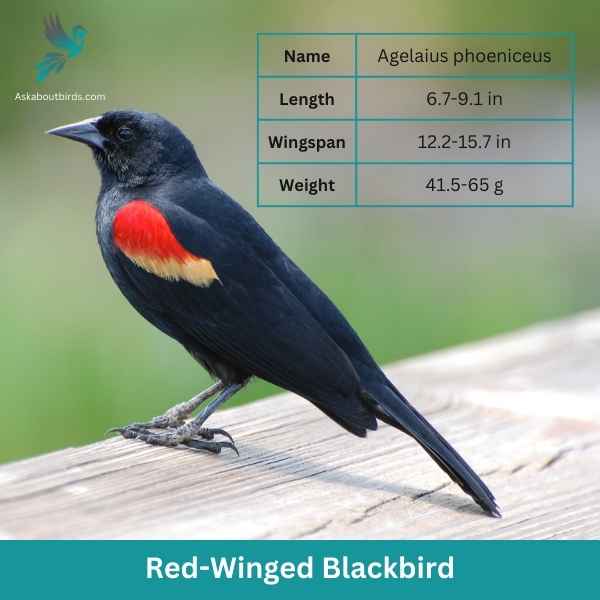
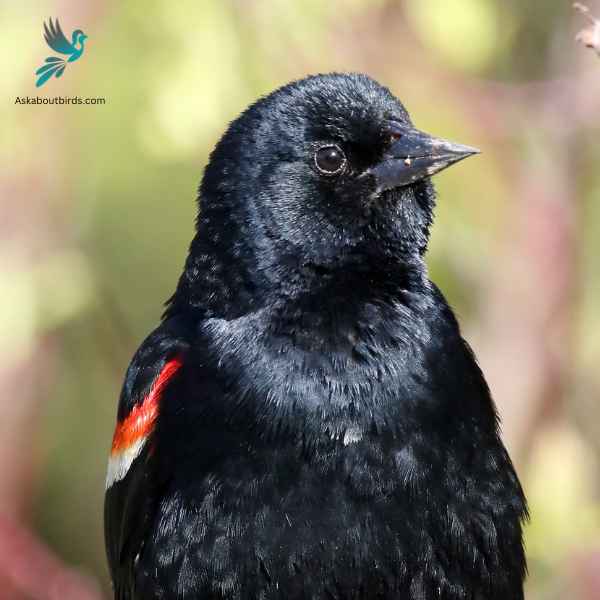
| Feature | Measurement |
|---|---|
| Scientific Name | Agelaius phoeniceus |
| Length | 6.7-9.1 in |
| Wingspan | 12.2-15.7 in |
| Weight | 41.5-65 g |
The Red-Winged Blackbird is a familiar sight across North America, especially in wetlands and open areas. Known for its striking coloration and distinct call, it is often seen perched on cattails or utility lines.
Appearance: Male Red-Winged Blackbirds are glossy black with bright red-and-yellow shoulder patches, while females are streaky brown, resembling a large sparrow. The males’ red patches become more prominent when they’re displaying or agitated.
Diet: Red-Winged Blackbirds primarily feed on seeds and insects. Their diet includes grains, sunflower seeds, and corn, but they also eat beetles, caterpillars, and other small invertebrates, especially in the breeding season.
Reproduction: Red-Winged Blackbirds nest in marshes, along watercourses, and in wet fields. The female constructs a cup-shaped nest using grass and sedge, attaching it to plants above water. She typically lays a clutch of 3 to 4 blue-green eggs, which she incubates for about 11-12 days. Males, being polygynous, often have multiple mates during a single breeding season.
House Finch
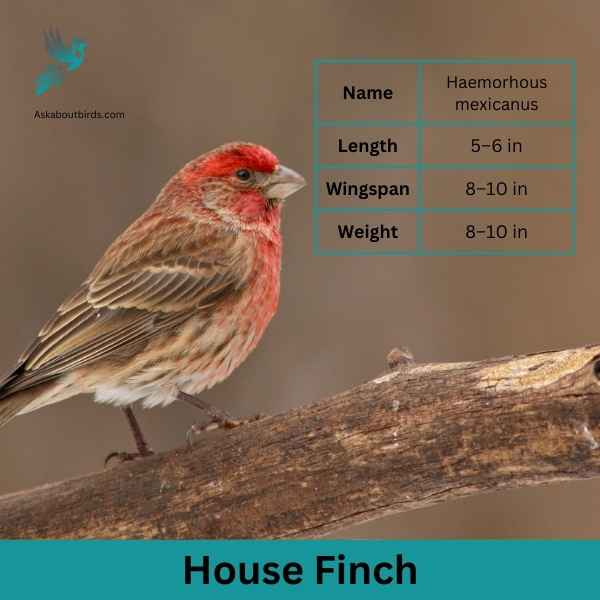
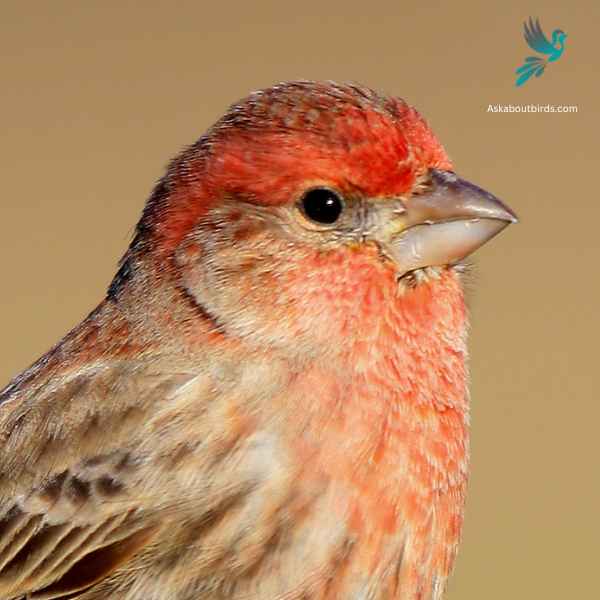
| Feature | Measurement |
|---|---|
| Scientific Name | Haemorhous mexicanus |
| Length | 5–6 in |
| Wingspan | 8–10 in |
| Weight | 0.6–0.9 oz |
The House Finch is a small songbird widely distributed across North America and is commonly found in urban and suburban areas.
Appearance: Males of this species are brightly colored with crimson faces and throats, which can extend to the chest and back, while their flanks have streaks. The female is streaked brown and lacks the red coloring. Both have a square-tipped tail and a distinctively long, flat-topped bill.
Diet: House Finches primarily eat seeds, grains, and berries. They have a particular fondness for sunflower seeds and can be commonly seen at bird feeders. Occasionally, they will also consume insects, especially during the breeding season.
Reproduction: House Finches are cavity-nesters and might choose ledges, vents, ledges, and other urban settings. They might also utilize trees or shrubs. Their nests can be made of a wide array of materials, from feathers to twigs.
Pine Grosbeak
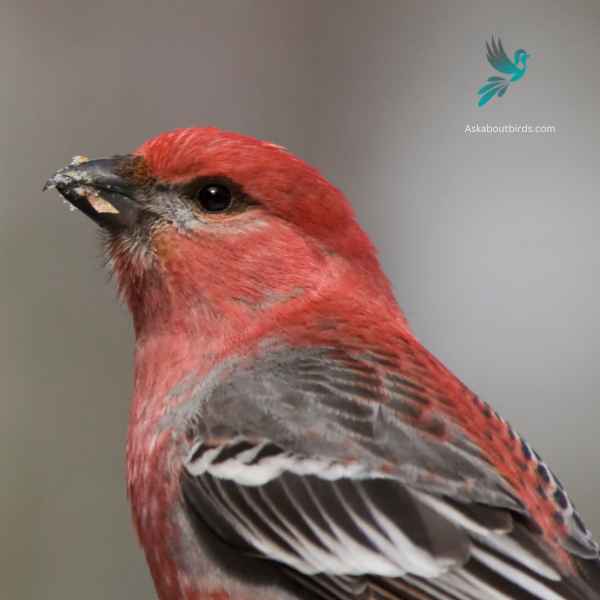
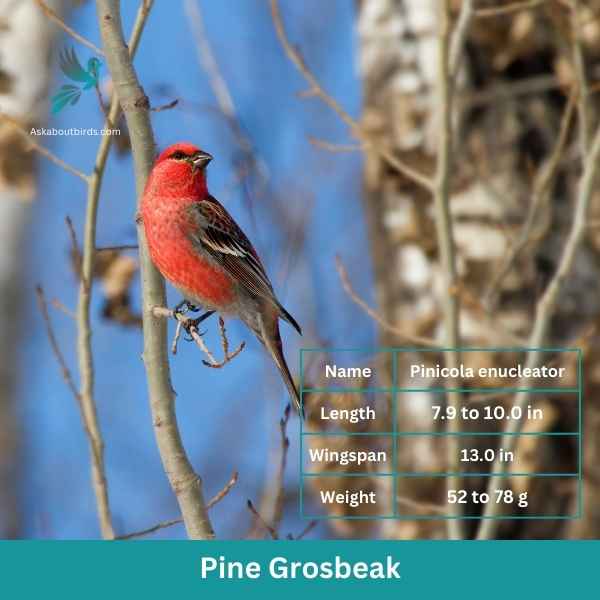
| Feature | Measurement |
|---|---|
| Scientific Name | Pinicola enucleator |
| Length | 7.9 to 10.0 in |
| Wingspan | 13.0 in |
| Weight | 52 to 78 g |
The Pine Grosbeak is a striking bird native to the northern regions of North America, often found in coniferous forests. Both males and females have a plump and robust body with a large beak adapted for eating seeds. The male Pine Grosbeak displays a vibrant reddish-pink plumage, while the female has a more subdued grayish-brown coloration.
These birds are typically seen in small flocks, foraging for food in trees and on the ground. They have a preference for seeds, particularly those from various conifer species. The Pine Grosbeak uses its strong bill to crack open the cones of tall trees and extract the seeds, but they also consume berries and small fruits when available.
Purple Finch
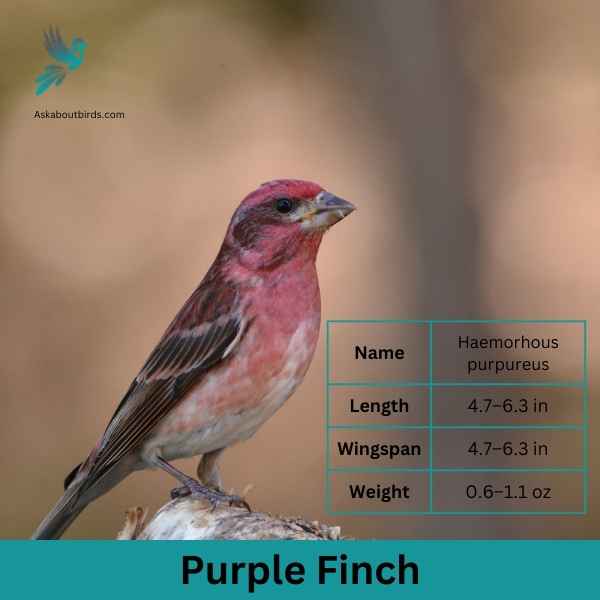
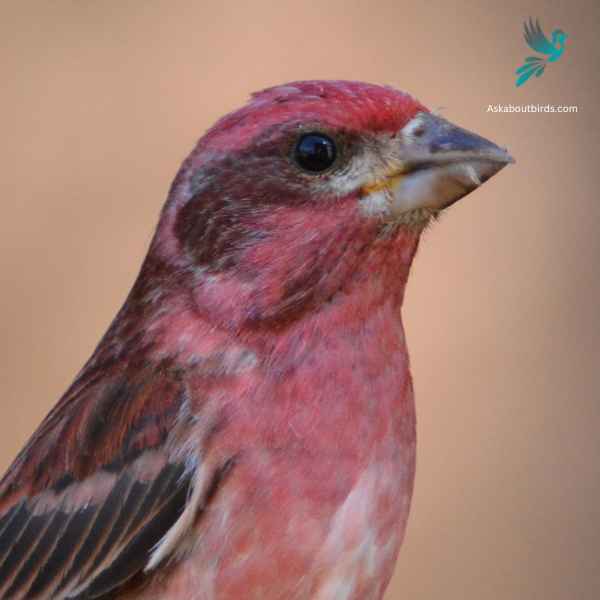
| Feature | Measurement |
|---|---|
| Scientific Name | Haemorhous purpureus |
| Length | 4.7–6.3 in |
| Wingspan | 4.7–6.3 in |
| Weight | 0.6–1.1 oz |
The Purple Finch is a vibrant songbird often mistaken for its close relative, the House Finch, but it exhibits a different hue and patterns.
Appearance: Males are raspberry red on the head, throat, and breast, with streaky brown backs and wings. The intensity of the red can vary among individuals. Females are brown and streaked all over but might show a slight blush on the face. They lack the strong facial patterns seen in female House Finches.
Diet: Purple Finches primarily consume seeds, with a preference for sunflower seeds, dandelion seeds, and buds. They also eat insects and berries, especially during the breeding season.
Reproduction: These finches often nest in conifers or mixed woodlands. The nest, typically located on a horizontal branch, is made from twigs and grass, then lined with feathers.
Red Crossbill
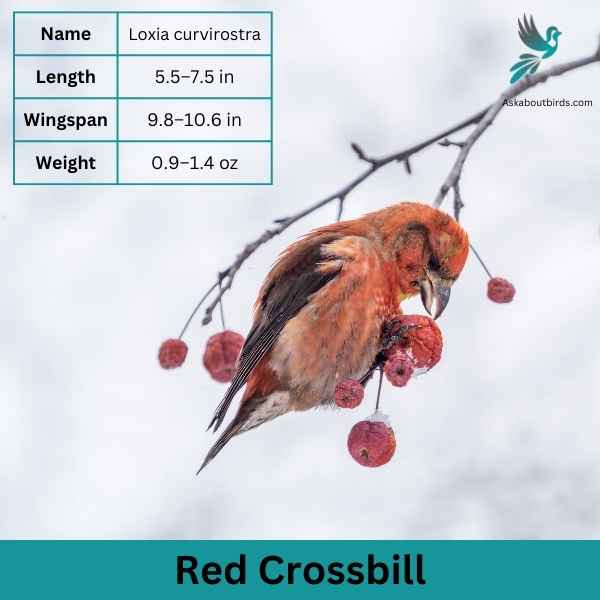
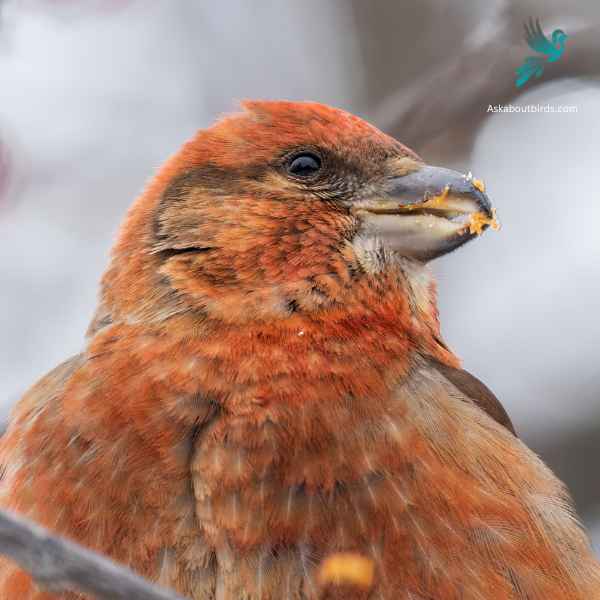
| Feature | Measurement |
|---|---|
| Scientific Name | Loxia curvirostra |
| Length | 5.5–7.5 in |
| Wingspan | 9.8–10.6 in |
| Weight | 0.9–1.4 oz |
The Red Crossbill is a distinctive finch known for its unusual bill, which has evolved to extract seeds from conifer cones.
Appearance: Males are typically bright red or orange, while females are greenish-yellow or olive. Both genders have the characteristic crossed bill, which they use to expertly extract seeds from tightly closed conifer cones.
Diet: Red Crossbills primarily feed on the seeds of coniferous trees, such as spruce, pine, and fir. Their specialized bills allow them to efficiently pry apart conifer cone scales to access the seeds.
Reproduction: Red Crossbills are somewhat nomadic and don’t adhere to a strict breeding schedule. Instead, they breed whenever and wherever food is abundant. Their nests are usually built on horizontal branches of conifer trees.
Red-naped Sapsucker
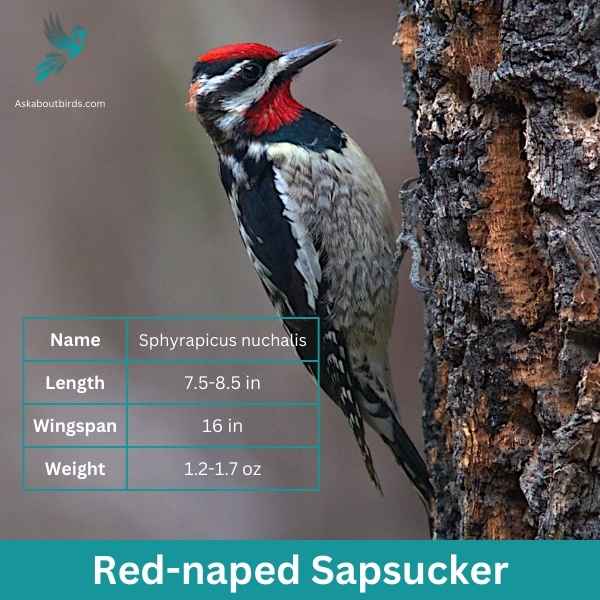

| Feature | Measurement |
|---|---|
| Scientific Name | Sphyrapicus nuchalis |
| Length | 7.5-8.5 in |
| Wingspan | 16 in |
| Weight | 1.2-1.7 oz |
The Red-naped Sapsucker is a medium-sized woodpecker commonly found in forests across the western North America, especially in mixed coniferous woods and aspen groves.
Appearance: This woodpecker is distinguished by its black-and-white barred pattern on the back and wings. A key feature is the bright red patch on the back of the head, which gives the bird its name. Both sexes have a white stripe down the side of the face, though males have a red patch on the throat, whereas females have a white one.
Diet: Red-naped Sapsuckers are named for their habit of drilling rows of shallow holes into tree bark to feed on sap and the insects attracted to it. They also consume ants, beetles, and caterpillars, and will sometimes eat fruits and berries.
Reproduction: These woodpeckers excavate nest cavities in trees, often selecting dead or decaying trees or limbs. After carving out a cavity, the female typically lays a clutch of 4 to 7 eggs. Both parents share responsibilities for incubation and feeding the chicks once they hatch.
Vermilion Flycatcher
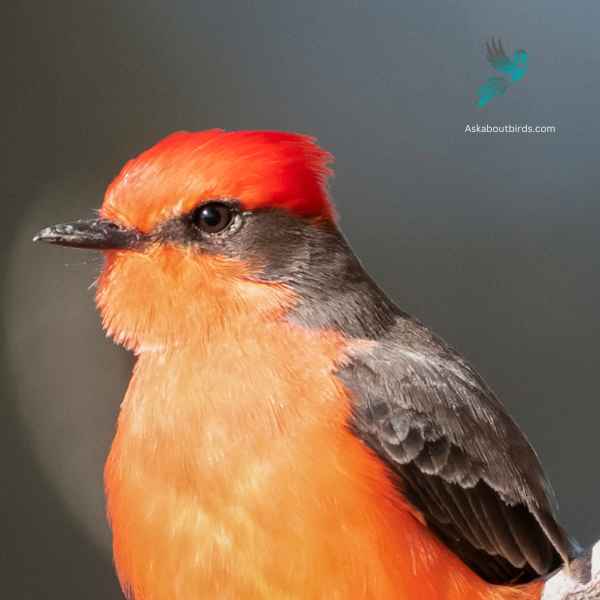
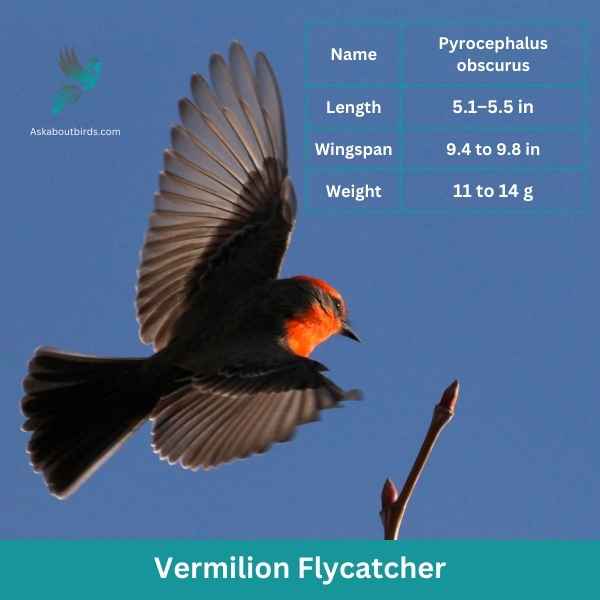
| Feature | Measurement |
|---|---|
| Scientific Name | Pyrocephalus obscurus |
| Length | 5.1–5.5 in |
| Wingspan | 9.4 to 9.8 in |
| Weight | 11 to 14 g |
The Vermilion Flycatcher is a small and colorful bird native to the Americas. The male Vermilion Flycatcher is a striking sight, displaying a vibrant red plumage on its head, breast, and underparts, contrasting with its brown wings and black tail below. Females, on the other hand, have more muted colors, featuring a pale yellowish belly and grayish-brown upperparts.
Vermilion Flycatchers are known for their lively and acrobatic flight displays, which they perform during courtship or to defend their territories. They often sing a series of soft, whistled notes while engaged in these aerial displays. They construct cup-shaped nests, usually in shrubs or low trees, where females lay their eggs and raise their young.
Summer Tanager
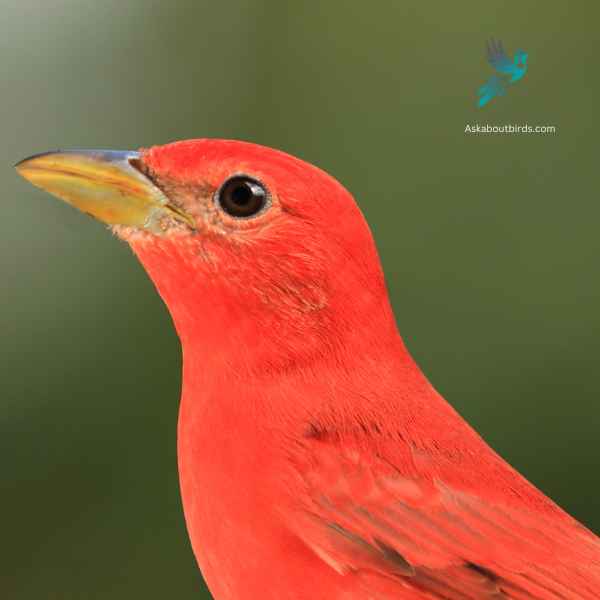
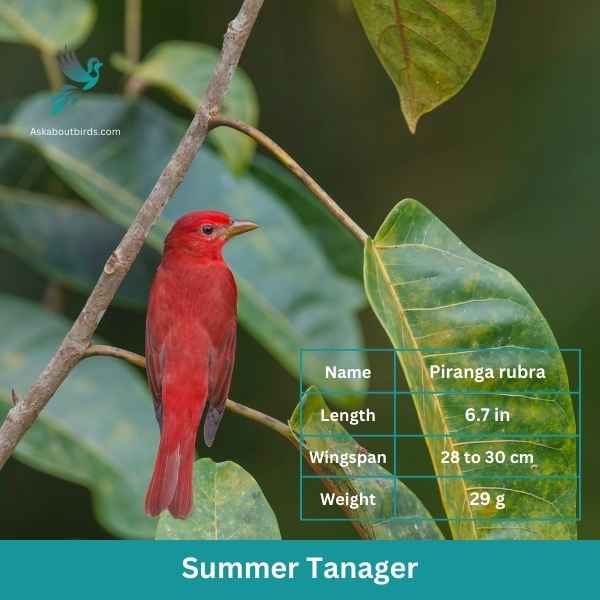
| Feature | Measurement |
|---|---|
| Scientific Name | Piranga rubra |
| Length | 6.7 in |
| Wingspan | 28 to 30 cm |
| Weight | 29 g |
The Summer Tanager is a medium-sized songbird admired for its radiant plumage and melodious song.
Appearance: Male Summer Tanagers are an impressive bright red, while females and juveniles present a softer, yellow-orange color. Both genders have a large, slightly hooked bill and relatively short tail.
Diet: Summer Tanagers primarily feed on insects, including bees and wasps, which they catch in flight or pick off vegetation. They are also known to eat fruits and berries, making them helpful in controlling pest populations and seed dispersal.
Reproduction: The female Summer Tanager builds a loose, shallow cup-shaped nest out of twigs and grass, usually hidden in the foliage of trees. The female typically lays 3-5 eggs, which she will incubate for about two weeks.
Scarlet Tanager
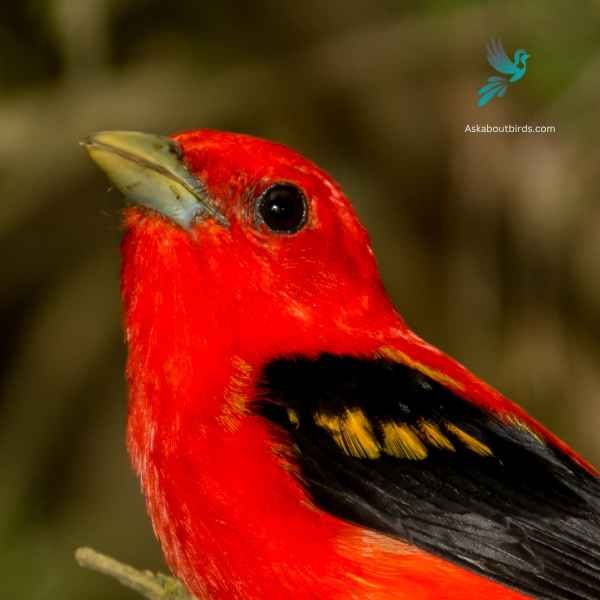
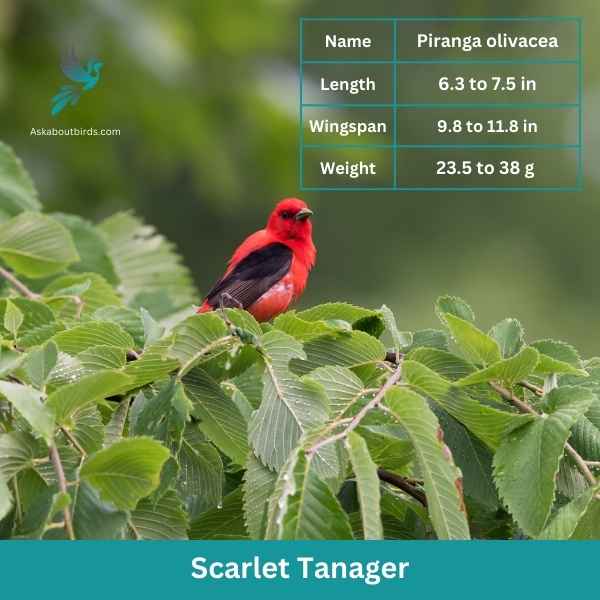
| Feature | Measurement |
|---|---|
| Scientific Name | Piranga olivacea |
| Length | 6.3 to 7.5 in |
| Wingspan | 9.8 to 11.8 in |
| Weight | 23.5 to 38 g |
The Scarlet Tanager is a strikingly colorful bird known for its brilliant plumage and distinctive song.
Appearance: Male Scarlet Tanagers are notable for their vibrant scarlet bodies contrasted with black wings and tail, making them one of the most intensely colored birds. Females and juveniles, on the other hand, have a subdued olive-yellow body color with darker wings and tail.
Diet: The diet of the Scarlet Tanager is largely made up of insects, including beetles, cicadas, aphids, and others. They are adept flycatchers, seizing insects in mid-air or picking them off foliage. They also consume fruits and berries, especially during migration and in their winter habitats.
Reproduction: The female Scarlet Tanager builds a cup-shaped nest using twigs, rootlets, and grass, typically well-hidden in the dense foliage of trees. She lays 3 to 5 eggs and incubates them for about two weeks.
Red-headed Woodpecker
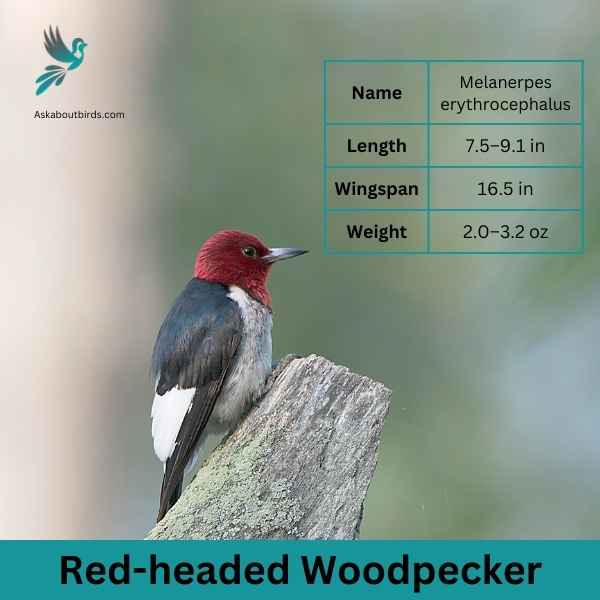
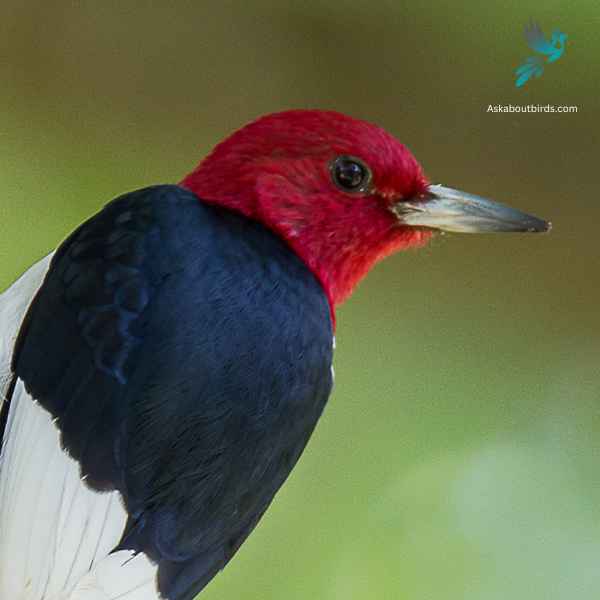
| Feature | Measurement |
|---|---|
| Scientific Name | Melanerpes erythrocephalus |
| Length | 7.5–9.1 in |
| Wingspan | 16.5 in |
| Weight | 2.0–3.2 oz |
The Red-headed Woodpecker is a striking forest bird with a bold tri-colored pattern.
Appearance: This woodpecker features a completely red head and neck, contrasting starkly with its white underparts and black wings. Its wings also have large white patches which are conspicuous in flight.
Diet: Red-headed Woodpeckers have a varied diet including insects, seeds, fruits, berries, and occasionally even the eggs of other birds. They’re also known to store food by wedging it into crevices in bark.
Reproduction: These woodpeckers nest in cavities which they excavate in dead wood or dead parts of live trees. These cavities can be found anywhere from 2 to 80 feet off the ground.
Where to Spot North Dakota’s Red Birds
From the shimmering waters of its lakes to the vastness of its prairies, North Dakota offers bird enthusiasts unparalleled opportunities to spot a myriad of species, especially the striking red birds.
- Lostwood National Wildlife Refuge: Nestled in the state’s northwestern region, this refuge boasts over 26,000 acres of native mixed-grass prairie and wetlands, providing habitat for both waterfowl and grassland birds. It’s a prime location for viewing Scarlet Tanagers and Red-headed Woodpeckers.
- Chase Lake National Wildlife Refuge: Home to one of the largest colonies of American White Pelicans, this refuge in central North Dakota is a birdwatcher’s paradise. Amidst the cacophony of pelican calls, keen observers can spot the vibrant Summer Tanager.
- Arrowwood National Wildlife Refuge: Located along the James River, the wetlands, prairies, and woodlands here are a haven for a wide range of birds. The Vermilion Flycatcher and Northern Red Bishop are occasional rare treats for the avid birdwatcher.
- Turtle Mountain State Forest: Positioned near the Canadian border, this forested region with its numerous lakes and wetlands is ideal for spotting Red Crossbills and other woodland birds.
- Devils Lake: As North Dakota’s largest natural lake, it’s a major stopover for migratory birds. The surrounding wetlands and woodlands are prime spots for observing various red bird species, including the elusive Red-necked Grebe.
| State’s Red Birds | Top Spots for Red Birds |
|---|---|
| South Dakota’s Red birds | 1. Custer State Park 2. Badlands National Park 3. Sand Lake National Wildlife Refuge |
| Montana’s Red birds | 1. Glacier National Park 2. Charles M. Russell National Wildlife Refuge 3. Bitterroot Valley |
| Minnesota’s Red birds | 1. Superior National Forest 2. Sax-Zim Bog 3. Tamarac National Wildlife Refuge |
FAQs on Red Bird Species Found in North Dakota
Why are Central and South America significant for bird migration?
Central and South America play a pivotal role in the migratory patterns of numerous bird species, including those with distinctive features like bright yellow-green coloring or gray wings. Many birds, after breeding in the northern and western states, migrate south to take advantage of the rich food sources and favorable climates. Forest canopies, city parks, and semi-open habitats across Central and South America teem with migratory birds, especially during the transition between seasons. The abundance of fruit trees and diverse environments make these regions a haven for both resident and migratory birds.
Why are black oil sunflower seeds popular in bird feeders?
Black oil sunflower seeds are a staple in many backyard feeders across the northern and western states as well as the eastern and southern states. Their high nutritional value attracts a variety of birds, notably bright red birds like the painted bunting. Birds with vibrant features, including those with two white wing bars or bright blue heads, frequent sunflower seed feeders, enhancing the bird-watching experience in city parks and forest edges.
How do white wing bars assist in identifying certain birds?
White wing bars are distinctive features that aid in bird identification. Birds like the painted bunting and white-winged crossbills are known to exhibit these markings. Especially when set against dark gray wings or brown plumage, these white wing bars become even more prominent. In regions of Central and South America, spotting these features can help differentiate between common residents and accidental or rare species.
What habitats are common for birds with bright red plumage in the Americas?
Birds with bright red plumage, such as the pine grosbeaks and painted bunting, are often found in diverse habitats across the Americas. Pine grosbeaks, for instance, predominantly inhabit evergreen forests where they feed on conifer seeds, especially from pine cones. On the other hand, painted buntings, known for their red body and green wings, prefer semi-open habitats in Central America and the southern and eastern states. Their presence in forest canopies and forest edges is a delightful sight for bird enthusiasts.

